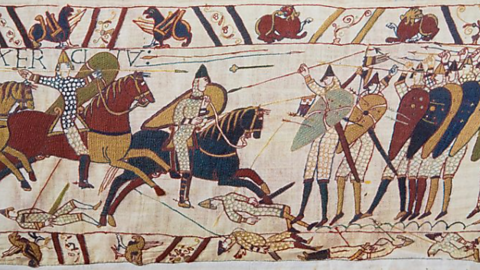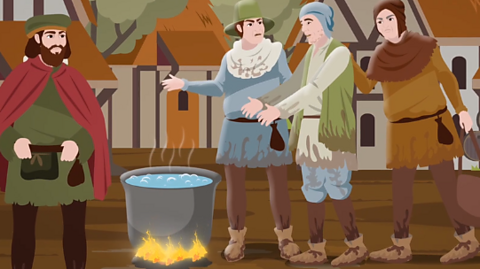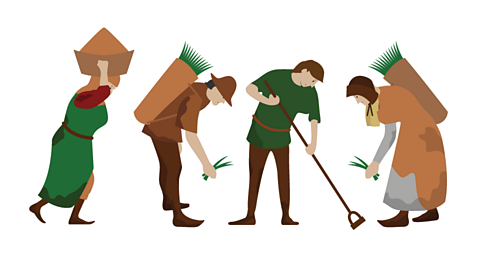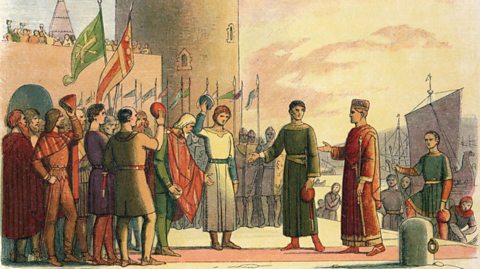Key points
- 1066 is one of the most famous years in English history. It included the death of two kings, two invasions, and consequences that would last for hundreds of years.
- The death of Edward the Confessor in January 1066 started a year of turmoil.
- Four key contenders all had strong claims to become the next king of England.
Video about the claimants to the throne
Watch this video to learn about the four claimants to the throne: Edgar the Atheling, Harold Godwinson, Harald Hardrada, and William of Normandy
Narrator: England in the 11th century was one of the best governed and wealthiest states in all Europe. There were plenty of silver coins in circulation and food was generally plentiful. The country was ruled by Anglo-Saxons, having fought off Vikings for hundreds of years, and local sheriffs meant people usually felt safe and secure. But on the 5th of January 1066, King Edward the Confessor put England in terrible danger. He died, without leaving a son and heir. This was a disaster. It left the country vulnerable to attacks from claimants battling for the prized English Crown.
The new king would need to be chosen by the Witan, the King’s councillors, an assembly of powerful nobles. But there were four people who each believed he was the most entitled to the throne. So who would the Witan choose?
First up was Edgar the Aetheling. He was the Anglo-Saxon prince and great-nephew of the late King. In 1057, Edward the Confessor had named Edgar’s father heir to the throne. But he died under suspicious circumstances before he could be crowned. Aged just 15, his son Edgar lacked both the experience and necessary support to become king.
Next up was the King of Norway, Harald Hardrada, or hard ruler- a formidable Viking warrior. His claim was also based on an earlier promise made to his father. Between 1016 and 1042, England had been ruled by Danish Vikings. The last of them was Harthacnut. Harthacnut had named Magnus, King of Norway, as his successor. But when Harthacnut died, the English crown went to Harthacnut’s Anglo-Saxon half-brother instead- none other than Edward the Confessor. Magnus died soon afterwards, so when the English crown came up for grabs again in 1066, Harald Hardrada leapt at the chance to claim back what he believed his father had been denied.
Then there was Harold Godwinson, an Anglo-Saxon, who believed he should be Edward’s successor. Harold was the Earl of Wessex, the richest man in the kingdom, and had good alliances with all the major nobles of England. He had been the late King’s advisor, governing the country on Edward the Confessor’s behalf, whilst the King was busy with his religious pursuits. King Edward had even married Harold’s sister, Edith. Harold also claimed the late King had promised him the throne on his deathbed. This assertion was backed up by the Anglo-Saxon Chronicles. But this was hardly surprising, as Harold was an Anglo-Saxon.
And finally there was William, Duke of Normandy, a distant cousin of the late King. Edward the Confessor had lived in Normandy for 25 years prior to his coronation, so he actually knew William better than his English nobles. England had been ruled by Anglo-Saxons or Vikings for the last 200 years. William was neither. William claimed that King Edward had promised him the throne, and this, of course, was the version reported by the Norman chroniclers. What’s more, William had many supporters, including the Pope in Rome, which meant, in effect, he also had the backing of God.
Question
Who were the main contenders for the throne in 1066?
Following the death of Edward the Confessor, there were several claimants to the English throne.
- Edgar the Atheling, who was the closest living relative to Edward, but was only a teenager.
- Harald Hardrada, who was related to a previous English king and claimed he should take the throne.
- Harold Godwinson, who was the Earl of Wessex and a powerful landowner in England.
- William, Duke of Normandy, who claimed he had been promised the throne by Edward.
Edward the Confessor
Edward the ConfessorKing of England from 1042-1066. He died without a direct heir, creating uncertainty about who his successor would be. was king of England from 1042 until his death on 5 January 1066. Normally, there is a clear line of successionThe order people are in to become the next monarch., and it is obvious who the next monarch will be. This was not the case when Edward died. He had no children, and his closest living heirA person who inherits a title or property when its owner dies. was his great-nephew Edgar the Atheling, who was just 14 years old. Edgar had not been supported or prepared for the role of king. It was decided that he was too young and inexperienced to rule and win the wars that would undoubtedly break out from rival claimants to the throne.
The three main rival contenders for the throne were Harold GodwinsonHarold was crowned King of England in January 1066. He defeated Harald Hardrada at Stamford Bridge before being killed in the Battle of Hastings., Harald HardradaA Viking leader who claimed he was the rightful heir to Edward the Confessor. His invasion was defeated at the Battle of Stamford Bridge. and William of NormandyA French noble who claimed he had been promised the English throne by Edward the Confessor. He invaded and won the throne at the Battle of Hastings. He is often referred to as William the Conqueror., who each claimed that they were the rightful heir to the English throne.
Claimants to the throne
Harold Godwinson
Harold Godwinson was from Wessex, in England. He was a wealthy nobleman, and it is claimed that Edward the Confessor named Godwinson as his successor on his deathbed. Harold Godwinson’s sister, Edith, was married to Edward, making Harold the king’s brother-in-law. Wessex was the largest kingdom in England and his claim would have been well supported by a large proportion of the English population.
William of Normandy
William was a Duke who controlled Normandy, a large region in northern France. William was a distant relative of Edward the Confessor and claimed Edward had promised him the throne in 1051.
William also said that Harold Godwinson had sworn an oath that he would help William take the throne after Edward, in return for helping Godwinson when he had been stranded in Normandy in 1064.
Harald Hardrada
Harald Hardrada was a Viking and king of Norway. He was also a distant relative of King Cnut, who had previously been a king of England when the Vikings had invaded. Harald Hardrada also had the support of Tostig, who was Harold Godwinson’s brother.
The two brothers had fallen out. Tostig had been the ruler of Northumbria since 1055, but people rebelled against his rule. The rebels said Tostig had been a selfish and strict leader. Harold Godwinson had advised Edward the Confessor that he should support the rebels, rather than his own brother! Edward agreed, and Tostig was replaced as Earl of Northumbria.
There were a number of ancestors of previous Viking invaders still living in the north of England, and they were supportive of Harald Hardrada’s claim to the throne.
Claimants to the throne activity
Learn more about the claimants to the throne with this activity.
Whose team are you on?
Who was crowned king?
On 6 January 1066, the day after Edward the Confessor died, the WitanA group of English nobility whose job was to advise the king. They had to make the decision on who to crown in 1066. met to decide who should be crowned king. The Witan were a group of powerful rulers whose job was to advise the king. They decided that Harold Godwinson should be crowned, and his coronation took place on the same day.
This decision angered both William of Normandy and Harald Hardrada. They each decided that, since they had not been given the English throne by the Witan, they would have to invade and take over by force. This led to two important battles: the Battle of Stamford Bridge, and later the Battle of Hastings.
The Battle of Stamford Bridge
In September 1066, Harald Hardrada and a force of 8000 Viking warriors invaded the north of England. They advanced to York and their numbers were boosted by supporters from Scotland and northern England.
The new king, Harold Godwinson, had been waiting in the south of England, anticipating an invasion from William from France. He quickly marched his army 185 miles north and reached Harald Hardrada’s men in just four days, taking them by surprise.
The two sides went to battle at Stamford Bridge, just outside of York. The Anglo-Saxon ChronicleA collection of manuscripts written while Alfred the Great was king, detailing useful information about life in Anglo-Saxon England. recorded that a Viking warrior blocked the bridge, stopping Harold Godwinson’s army from crossing. One of Godwinson’s soldiers floated under the bridge in a barrel and stabbed the Viking through the slats in the bridge, allowing the rest of the English army to cross the river.
After a violent battle, Harold Godwinson was victorious. Both Hardrada and Tostig were killed and the remainder of Hardrada’s army were allowed to return to Norway.
Test your knowledge
Teaching resources
Searching for more content to add to your history lesson plans? This 5-minute animated video tells the story of Edgar Aethling, Harald Hardrada, Harold Godwinson and William of Normandy, all claimaints to throne in 1066.
BBC Teach has thousands of free, curriculum-linked resources to help deliver lessons - all arranged by subject and age group.
GCSE exam dates 2025
Find out everything you need to know about the 2025 GCSE exams including dates, timetables and changes to exams to get your revision in shape.

More on The Normans
Find out more by working through a topic
- count2 of 6

- count3 of 6

- count4 of 6

- count5 of 6
